Popularity of anti-VEGF therapies sparks debate over when and how to treat
A panel of experts, moderated by OSN Retina/Vitreous Section Editor Carmen A. Puliafito, MD, MBA, discussed controversial case studies at the Retina 2008 meeting.

Carmen A. Puliafito, MD, MBA: Let’s look at what has happened in the treatment of wet macular degeneration in the last 12 months. As Kevin Corcoran, COE, CPC, has pointed out, retina is making history because intravitreal injections are now No. 3 on the list of ophthalmic procedures coded for Medicare reimbursement, following cataract with IOL and Nd:YAG laser.
There were only a few of us doing intravitreal injections back in 1999, 2000 and even 2002. But since then, there has been an exponential growth in the number of intravitreal injections. There are some procedure codes that went down in ophthalmology: Laser to the choroid and focal laser have actually declined in the last year.
So the practice of retina is changing. The big question for most practitioners is, how do we decide between Avastin (bevacizumab, Genentech) and Lucentis (ranibizumab, Genentech) when selecting a drug?
Genentech took a few actions in 2007 that actually changed the landscape. The first thing it did was decrease the billing cycle time for Lucentis from 80 days to 55 days, a decision that was greeted by tremendous outcry and was subsequently reversed.
Later in the year, it banned direct sales of Avastin to compounding pharmacies. This decision has been partially reversed.
Let’s go to our cases now. The first case is an 81-year-old man with a history of wet AMD in the left eye and new onset of blurred vision in the right eye (Figure 1). Best corrected vision in the right eye is 20/30. What would you do with this patient?
| |||||||||||
Peter K. Kaiser, MD: The worrisome thing here is that you have a very large pigment epithelium detachment (PED), so the risk of treating this patient is a retinal pigment epithelium (RPE) tear. Thus, you need to make sure that patient is actually experiencing disease progression in the form of either a loss of vision, increase in size of the lesion or some other sign of recent activity, such as hemorrhage, before actually doing anything. I have seen patients such as this who can remain stable for a very long time with absolutely no worsening in their symptomatology. Another thing to look for is to make sure the patient has choroidal neovascularization (CNV). In this case, you can see the CNV more superior, so it is not just a serous PED, which I do not treat.
So to answer your question, if the patient is stable, I would not do anything. If the patient started to exhibit signs of decreasing vision or hemorrhage, then I would treat this lesion with Lucentis monotherapy.
Andrew P. Schachat, MD: Those three hyperfluorescent spots for me indicate that it is a minimally classic lesion. So I would start with ranibizumab and not wait for disease progression.
Sharon Fekrat, MD, FACS: I agree with what Dr. Kaiser said. I would want to be convinced that this was getting worse because the PED component is so large that I would not want to end up with an RPE rip and a decrease in vision or a bleed.
Steven D. Schwartz, MD: I would like to see a spectral-domain optical coherence tomography (OCT) on this patient.
Dr. Puliafito: Let’s say we do not have one in this case.
Dr. Schwartz: In that case, I would just go ahead and treat this patient with an anti-VEGF agent.
Gary C. Brown, MD, MBA: It looks to me like more of a retinal angiomatous proliferation (RAP) or a pseudo-RAP-type lesion. I would treat with an anti-VEGF agent.
Dr. Puliafito: So we do have an OCT on this patient (Figure 2). The patient was treated with Avastin and did very well. Are you surprised?
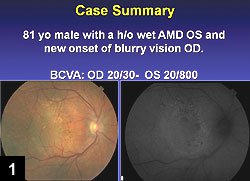 This 81-year-old male has wet AMD in his left eye and BCVA of 20/30 in the right eye. | 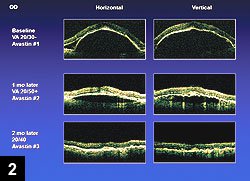 OCT shows patient responded well to bevacizumab in the AMD eye. | |
| Images: Puliafito CA | ||
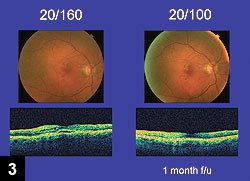 Patient who received ranibizumab injection showed notable improvement at 1 month. | 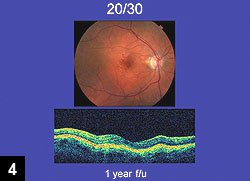 Patient injected with ranibizumab at 1 year follow-up, presented by Elias Reichel, MD. | |
| Images: Reichel E | ||
Elias Reichel, MD: In this case, I am surprised. I thought this patient would not respond as well as he did. But some do and some do not.
Dr. Puliafito: Dr. Kaiser, do you think this is a typical response for a patient with this kind of lesion 2 months later?
Dr. Kaiser: I think it is a relatively atypical response. To see the PED suck down so quickly actually surprises me.
Dr. Puliafito: I would say that, too. I think this is much better than you would typically expect. Dr. Fekrat, if the patient had a serous PED, let’s say this really does look like a neovascular-based PED, would you still treat the patient with Avastin or Lucentis? Say the guy came in at 20/50, a 55-year-old patient with a new serous PED, and the fluorescein and the indocyanine green angiography show just the serous PED and not the hint of a neovascular membrane. Would you treat that patient?
Dr. Fekrat: No, I would not — at least not initially. I would probably see them back in about 4 weeks and then make a decision.
Dr. Puliafito: What if in 4 weeks they are still complaining about horrible metamorphopsia?
Dr. Fekrat: Then we would have a discussion about the possibilities, and then we might go ahead and do it.
Dr. Puliafito: Dr. Brown, what would you do? In serous PED, do the anti-VEGFs work at all? Would you do it?
Dr. Brown: No, I do not think they do in serous PED without a net. But I think if you do see a serous PED beneath subretinal fluid in an older person, there is a very high chance of having a net, and that is an indication for treatment.
When to re-treat
Dr. Puliafito: The next case is Dr. Reichel’s case, so why don’t you present it?
Dr. Reichel: This patient came in with 20/160 vision with minimal fluid (Figure 3). There is a small cyst that you can see within the retina. How would you manage at the 20/160 level?
Dr. Kaiser: Presumably this is not a re-treatment OCT. This is at baseline?
Dr. Reichel: This is at baseline. This is new.
Dr. Kaiser: First off, just to be sure it is CNV, I always get a fluorescein angiography at baseline. Since Dr. Reichel is presenting it, I would presume it is CNV, but I like to get fluorescein angiographies at baseline. I do not get them at follow-up visits unless I am deciding whether to switch treatments. For follow-up visits, I get an OCT. Assuming there is a CNV on the fluorescein angiography, I would treat this patient with Lucentis.
Dr. Reichel: The patient was treated with Lucentis. One month later, the vision was 20/100. What are you going to do at that point?
Dr. Schachat: I usually do not do the three treatments and then go to as-needed dosing. I am waiting for the data from the new trials to know what to do. So if I thought there was still a little bit of fluid, I would treat again. There is absolutely no guiding data at this point to say one way or the other, whether it is correct to treat again or not.
Dr. Reichel: Is anyone on the panel treating three times and then following? Would anyone have done that?
Dr. Fekrat: I would do three treatments, and then I would regroup and evaluate what to do. I often find myself using Lucentis three times and then switching over to Avastin for the longer interval if there is any fluid after three treatments.
Dr. Reichel: What is the rationale for that? Why do three treatments? At this point, this looks great, 20/100 vision. Is there going to be an improvement in vision with further injections? Is the anatomy going to get better?
Dr. Fekrat: No.
Dr. Reichel: Or are you afraid there is going to be a washout and that there can be recurring tissue loss?
Dr. Fekrat: Right. Then if I did not treat her, then I would have to bring her back sooner just to check to see if leakage was starting to return.
Dr. Schwartz: I think the other point that is probably worth mentioning here is that one slice on the OCT 3 does not mean a dry macula. I think we see a huge difference in the number of “wet maculas” on the new spectral domain OCTs vs. the older OCTs. So it is a little bit disingenuous to just show one slice.
Dr. Reichel: Absolutely.
Dr. Brown: I would treat three times, and then I would go as needed.
Dr. Puliafito: It is interesting. I actually treat once and then watch. But now this is a little different, right, Dr. Reichel? Would you treat once and then watch?
Dr. Reichel: I would still follow that patient.
Dr. Puliafito: You would not re-treat?
Dr. Reichel: I would not re-treat.
Dr. Puliafito: You don’t think that the patient may have some fluid hiding somewhere?
Dr. Reichel: Based upon the examination, no. And with 20/20 vision and a normal OCT, I would not re-treat.
Dr. Puliafito: But what about 20/100?
Dr. Reichel: This patient actually was 20/100, and I will tell you that we did not re-treat. Because the architecture looked normal. The vision was heading in the right direction.
Dr. Kaiser: I like to be more proactive, rather than waiting for the fluid to come back before treating. So I use a “treat-and- extend” paradigm and would treat the patient again at this visit and then see him back in 2 months instead of a month.
If they come back in 2 months and they are still dry, I would hit them again and see them back in 3 months. If they are wet at 2 months, then I know I cannot go beyond 2 months, treat again and see them in 2 months or less. By using this paradigm, I minimize the visits and injections and hopefully maximize the outcome.
Dr. Fekrat: That is similar to my approach to these patients.
Dr. Reichel: This is very early disease. This patient came in immediately after symptoms started in this eye. And if you look at the OCT or fluorescein, there is some mild stippling within the center of the fovea.
Dr. Schwartz: If it is early disease, why are they 20/100 with normal architecture?
Dr. Reichel: Early in the sense of symptoms. They are coming in a month after symptoms appeared. Now, if they had waited 6 months, does that bias you? If you have a patient who has been symptomatic for 6 months, are you going to be more aggressive and do three treatments as opposed to one treatment?
Dr. Schwartz: I am a little bit confused about how to best manage these cases personally. Why? Because I have patients, in my experience, who I have stopped treatment after one or two injections for whatever reason and have remained dry. Often, they continue to improve visually for a long time after we stop injections. And the vision actually ticks upward when we stop. And I have the exact opposite experience when they remain dry, and I continue to give them one or two injections, and the vision ticks downward. So I am at a loss at this juncture of when to stop. It is a very hard area, and I think the PrONTO data is probably the most reasonable guide right now. And I can say this is a total reversal for me because at the beginning of the anti-VEGF era, I was very much a monthly injector.
Care should be taken not to generalize across all lesions as to when to inject or what to inject. I think we still have some discovery to do here, and I believe one relatively quick step forward will come from all the new data yielded with spectral- domain OCT.
Dr. Reichel: So this is 1-year follow-up, and the patient is 20/30 (Figure 4). I think the teaching point here is, as Dr. Schwartz said, we do not know. We cannot predict the future. Hopefully the CATT trial will teach us that there is going to be a subgroup of patients where there is minimal treatment. There is going to be another subgroup of patients we are going to have to treat every month.
Dr. Puliafito: Does anybody on the panel think that by looking at that patient the first time they come in you can say, “This patient is going to need five injections or two injections or one?”
Dr. Fekrat: There really is no way to predict that.
Dr. Puliafito: See if you agree with the following statement: A patient comes in with 20/40 vision and a little subretinal fluid, very early occult disease. It may be that this patient will be a chronic leaker, but those are the patients who most likely will not need to be hammered with treatment. Is that a true statement or false statement?
Dr. Reichel: True.
Dr. Puliafito: There is a group of patients that need to be characterized. They go to their local ophthalmologists and see that they have a little distortion. They have in both eyes occult disease with a little subretinal fluid, a little intraretinal edema, vision is 20/40, 20/30. They are not really complaining a lot. And you can treat those patients and never dry them up.
Submacular Surgery Trials
Dr. Puliafito: Now let’s move on to the advanced case. This patient is 88 years old, and he has had decreased vision in his left eye for 5 days (Figure 5). His right eye is 20/40 and his left eye is 7/200. He is a pretty active guy and wants to know what you would do. Dr. Brown, what would you do?
Dr. Brown: I would treat him with an anti-VEGF agent, either Lucentis or Avastin. I would probably treat him at least three times with 4 to 6 week periods in between and see how he did. I might even continue monthly on this particular case because some of these people, when that bleb resolves, can get a pretty decent visual result.
Dr. Schwartz: The Submacular Surgery Trials (SST) taught us a lot about these lesions. First, the control group taught us that some eyes do well with observation. Some eyes do poorly with surgery and some do well with surgery, so there was really no difference between surgery and observation, at least as it happened in the SST. The fellow eye is good here. The SST also taught us that large macular hemorrhages are a bad prognostic sign and can signal major systemic issues and even death. This may be a severely ill patient, so I would tend to communicate with the internist and family, while considering the excellent vision in the fellow eye.
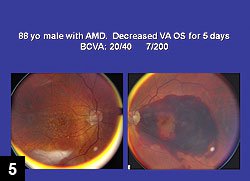 88-year-old patient with advanced AMD has 7/200 vision in his left eye. Images: Puliafito CA | 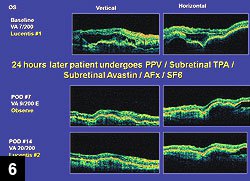 OCT of same patient reveals no systoid macular edema or subretinal blood at days 7 or 14. | |
| Images: Puliafito CA | ||
I would say you have to watch what you are going to give him here. This is a 20/20, 20/40 fellow eye. Ask me what I would do if it was a second eye. In the fellow eye, we can be more aggressive.
Dr. Kaiser: But if this patient had 20/20 or 20/40 vision in this eye before this bleed, I think doing nothing is basically kissing the eye goodbye. So I think doing nothing is not reasonable.
In the hemorrhagic arm of the SST, they did not perform the surgery we would consider in this patient — namely subretinal tissue plasminogen activator (tPA) with gas displacement plus/minus Lucentis injection. The operation we performed in the SST was very different. First, you did not have to use tPA. Second, you had to remove something from the subretinal space. This was supposed to be the CNV, but in most cases it was just clot with photoreceptors attached. Although no randomized trials have been performed, the results using tPA displacement have been considerably better than the SST results.
Dr. Schwartz: Clearly I agree that the SST surgical protocol had issues. Nonetheless, we still learned a lot from the trial, especially the natural history side.
Dr. Kaiser: If there is thick blood involving the fovea, I would do surgery on this patient. I do not particularly believe in pneumatic displacement. What I would do is a complete vitrectomy, inject subretinal tPA and then displace the blood out of the fovea with a partial air-fluid exchange and positioning. I would also inject an anti-VEGF agent afterward.
Dr. Schwartz: At UCLA, when we operate on these patients, our protocol is similar except we actually intraoperatively place the anti-VEGF agent under the retina at the time of the tPA placement; tPA placement should concentrate on the inferior margin of the clot to facilitate atraumatic inferior displacement. We have had some nice results with it.
Dr. Puliafito: Dr. Reichel, can you interpret the preoperative OCT (Figure 6)? What does that show?
Dr. Reichel: There is a significant amount of subretinal hemorrhage, probably. And then on the horizontal, there is another pocket. There is not a lot of cystoid macular edema, although there are a few cysts. And then the architecture of the retina, this is a great result. There is a PED. You can see there is something under the RPE, but there is no cystoid macular edema, there is no subretinal blood in either of them, either in day 7 or day 14.
History of anticoagulants
Dr. Puliafito: If a patient comes in to see you and they have had bleeding in this eye, what do you tell them about anticoagulants? What kind of history do you take?
Dr. Fekrat: I usually want to know what anticoagulants they are on.
Dr. Puliafito: Let’s say aspirin.
Dr. Fekrat: Well, look and see why they are on the aspirin.
Dr. Puliafito: They watch TV and have seen a commercial that says aspirin is good for you. They could not get an appointment with their doctor so they just started taking it.
Dr. Fekrat: I usually do not change their anticoagulants because I tell them it does not make them bleed, but if they are going to bleed, they will bleed more.
Dr. Puliafito: Dr. Brown, do you think that patients who take aspirin are more likely to have a big subretinal hemorrhage associated with AMD?
Dr. Brown: I do not think so. I do not think anybody has shown that at all, but I do think there are quite a few cases that have come to the pathology lab of people with AMD who were on Coumadin (warfarin sodium tablets, Bristol-Myers Squibb), and then they develop a massive, internal expulsive hemorrhage without any type of perforation or trauma.
Dr. Puliafito: Now, do you think that if you are taking Plavix (clopidogrel bisulfate, Bristol-Myers Squibb/Sanofi Aventis) and you get macular degeneration, will that increase your chance of having a big subretinal hemorrhage?
Dr. Kaiser: The issue here is, does the anticoagulation increase the risk of a bleed, period. And the answer is probably not, but if you have a bleed, it is just going to be larger. Personally, if a patient told me, “I’m taking aspirin,” I would let them continue the aspirin. And if they are taking Coumadin, I would definitely continue the Coumadin. I do not think that we are going to be stopping the natural history. I always tell patients, “The eye doesn’t work if the heart doesn’t work.” So I leave them on it.
 Highly myopic patient presents with extensive hemorrhage. Image: Puliafito CA | ||
Dr. Puliafito: My prejudice on this is, I halt self-prescribed aspirin in patients with significant macular degeneration. Obviously, there are patients taking Plavix for legitimate cardiovascular reasons, and that is not for us to interfere.
Dr. Schwartz: On the anticoagulation front, the devil is in the details. I check if patients are therapeutic or overmedicated. Are they on two or even three agents? Are these necessary? It is astounding how many medication mistakes we find when we look.
Dr. Puliafito: I think if you have a large subretinal hemorrhage, you have severe macular degeneration, and they are likely to not do great no matter what you do.
Highly myopic patients
Dr. Puliafito: Moving on to another case. Here is a patient with myopia (Figure 7). So what do you do about this, Dr. Reichel?
Dr. Reichel: That is a little bit more extensive hemorrhage than we would typically see with myopic CNV. I would inject Avastin and follow this patient closely. They do exceedingly well.
Dr. Puliafito: Would anyone use Lucentis instead? Do you think there is a difference in this setting?
Dr. Reichel: Lucentis vs. Avastin? It is the cost that is the difference.
Dr. Puliafito: Here is the OCT. This patient received Avastin (Figures 8 and 9). Do you want to comment on the OCT, Dr. Reichel?
Dr. Reichel: You can follow it over time, and 1 month later you are seeing more normal architecture to the central macula (Figure 9). It shows on the vertical as well. So anatomically, things are looking good; visually, it is not that great.
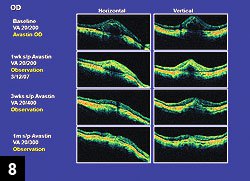 Anatomical changes as seen on OCT up to 1 month follow up after bevacizumab injection. | 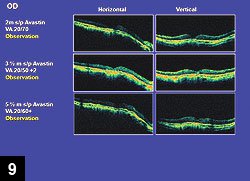 OCT images at 2-, 3.5- and 5.5-month follow-up visits. | |
| Images: Puliafito CA | ||
Dr. Puliafito: What about angioid stress?
Dr. Schachat: I am much less likely to treat at all because the natural history is better than AMD. So without treatment, the result is better than the natural history of CNV in AMD. And we do not know what the risks are because we do not have a large series of injections in myopes. But the risks have to be higher as far as retinal detachment because myopes’ baseline risk of retinal detachment is higher. So I assume the risk-benefit ratio is not as favorable as for AMD.
Dr. Puliafito: So you would treat this patient?
Dr. Schachat: The hemorrhages can just go away, and there may not be CNV. There is already a lot of atrophy there. I predict there is going to be atrophy if I treat them or not.
Dr. Puliafito: This patient did OK. Do you think that these patients need less drug?
Dr. Reichel: Absolutely.
Dr. Fekrat: I think so.
Dr. Puliafito: Why?
Dr. Reichel: It is a more indolent disease, but they do need something. How many people have seen a retinal detachment in a myopic patient with an intravitreal injection? The risk is low.
Dr. Puliafito: I think the risk is low, but I would state the following: Make sure you put it in the informed consent. Make sure you talk to the patients about the fact that they are at an increased risk of retinal detachment.
Reduced-fluence PDT
Dr. Puliafito: Now, on to some questions for the panel. Dr. Kaiser, do you reduce the fluence of photodynamic therapy in combination with anti-VEGF therapy?
Dr. Kaiser: Yes, I do reduced fluence on almost everything.
Dr. Puliafito: Can you explain what you mean by reduced fluence and how you achieve it?
Dr. Kaiser: Sure. The way PDT works is related to the amount of oxygen in the area around where the photochemical reaction is occurring. The oxygen is necessary to produce the singlet oxygen and free radicals that produce the angio-occlusion. If you talk to PDT researchers, they think that we are giving patients a dramatic overdose with our standard PDT treatment, in that we are using up the oxygen right at the beginning of the reaction. So we are getting actually less of an effect than we would want. And so by reducing the fluence, we theoretically are getting more of an effect with less damage to the retina.
Dr. Puliafito: Do you decrease the time in half or change the fluence?
Dr. Kaiser: Decreasing time does not necessarily reduce fluence. It decreases the light dose. So for example, if we are using up all of the oxygen in the first 10 seconds, then applying PDT light for 10 seconds or 83 seconds results in the same effect. If you go 20, 60 or 83 seconds, it does not matter if you use it up in 10 seconds. By reducing the fluence, it is totally different. Now, how much we should reduce the fluence is a total guess. So I base it on the only study that we have, which is the VIM (Verteporfin In Minimally classic CNV due to AMD) study, in which they reduced the fluence in half.
Dr. Puliafito: Do you do all of your PDT treatments at reduced fluence?
Dr. Kaiser: All of them, yes, except a choroidal hemangioma, in which I would use full fluence.
We have some data to support that you get less inflammation and less VEGF being produced with reduced fluence, and the efficacy results appear to be better.
Dr. Puliafito: When do you use PDT for treating choroidal neovascular membranes secondary to AMD?
Dr. Kaiser: Despite all of the studies, I still start with Lucentis monotherapy. That is, unless the patient has said to me specifically they cannot come back because they have transportation issues or they are coming from a foreign country. In those patients, I would consider doing combination therapy with PDT right off the bat. But typically, I do not switch to combo until I see that the patient is not doing well with monotherapy.
Interval of treatment
Dr. Puliafito: When is it safe to see a patient every 3 months vs. every 6 weeks? Anybody want to take this?
Dr. Reichel: I do not think anyone knows.
Dr. Kaiser: I will take a stab at that. There is no way to know, but one of the things that Philip J. Rosenfeld, MD, PhD, has shown us is that patient re-treatment rates fall into a pattern. If you can figure out that patient’s pattern, then you could feel pretty comfortable following them at that interval. So if a patient needs treatment every 3 months, you can feel pretty comfortable seeing them at 3-month intervals. But you cannot get to that interval until you have worked up to it by treating and extending. You cannot just suddenly say to a patient at baseline that you will see them in 3 months.
Dr. Schwartz: Also, an intelligent, observant patient can often be trusted to come back when they are symptomatic vs. the majority of patients who cannot be trusted. So there are patients who you can get into a comfort zone with.
Dr. Kaiser: I have a question for the panel. What do you do for bilateral CNV?
Dr. Puliafito: I would do double-barreled treatment the day they show up. That is the most likely thing.
Dr. Fekrat: I do not treat my patients in each eye on the same day. I will stagger it by a few days or a week. But I have done both eyes on the same day for a few select patients with transportation problems.
Dr. Puliafito: I think that if possible, in the best of all circumstances, never operate on both eyes on the same day. But usually the best of circumstances does not occur.
I would like to thank our panel for taking part in this interesting discussion.
For more information:
- Gary C. Brown, MD, MBA, can be reached at the Center for Value-Based Medicine, P.O. Box 335, Flourtown, PA 19031; 215-353-6249; fax: 215-233-3222; e-mail: gbrown@valuebasedmedicine.com. Ocular Surgery News could not confirm whether Dr. Brown has a direct financial interest in any of the products mentioned in this article or if he is a paid consultant for any companies mentioned.
- Sharon Fekrat, MD, can be reached at the Vitreoretinal Surgical Service at the Duke University Eye Center, Durham, NC 27710; 919-681-0341; e-mail: sharon.fekrat@duke.edu. Dr. Fekrat has no direct financial interest in the products mentioned in this article, nor is she a paid consultant for any companies mentioned.
- Peter K. Kaiser, MD, can be reached at the Cole Eye Institute, Division of Ophthalmology, A31, 9500 Euclid Ave., Cleveland, OH 44195; 216-444-6702; e-mail: pkkaiser@aol.com. Dr. Kaiser is on the scientific advisory board for Genentech, Novartis and QLT.
- Carmen A. Puliafito, MD, MBA, can be reached at Office of the Dean, Keck School of Medicine, University of Southern California, 1975 Zonal Ave., KAM 500, Los Angeles, CA 90033; 323-442-1900; e-mail: cpuliafito@usc.edu. Dr. Puliafito has no direct financial interest in the products mentioned in this article, nor is he a paid consultant for any companies mentioned.
- Elias Reichel, MD, can be reached at the New England Eye Center, 750 Washington St., Box 450, Boston, MA 02111; 617-636-1648; e-mail: ereichel@tufts-nemc.org. Dr. Reichel is a consultant for Genentech.
- Andrew P. Schachat, MD, can be reached at Cole Eye Institute, i-30 Cleveland Clinic, 9500 Euclid Ave., Cleveland, OH 44195; 216-444-7963; e-mail: schacha@ccf.org. Dr. Schachat is a consultant for NeoVista.
- Steven D. Schwartz, MD, can be reached at Jules Stein Eye Institute, University of California, Los Angeles, 100 Stein Plaza, Los Angeles, CA 90095; 310-206-7474; fax: 310-825-3350; e-mail: schwartz@jsei.ucla.edu. Ocular Surgery News could not confirm whether Dr. Schwartz has a direct financial interest in any of the products mentioned in this article or if he is a paid consultant for any companies mentioned.







